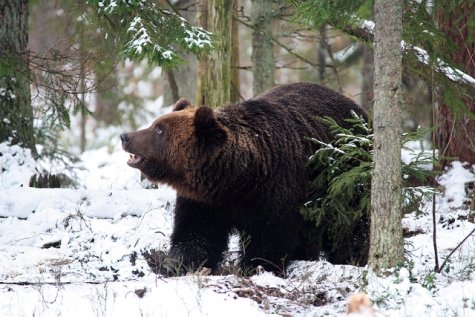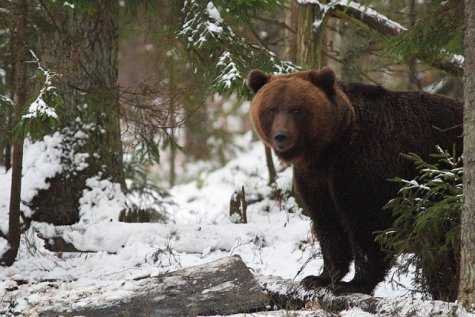At the ending of the Alutaguse forest camera season
Text and photos Peeter Anijalg
Translation: Liis
How I went to wish the Alutaguse bears a pleasant sleep
I was in the Alutaguse bear hide for two nights the week before last hoping to see the ruler of our forests – the brown bear. The first night was a few days after the first snow of this year and while the bears had been showing up in camera view already at 4-5 pm then that night the first one turned up from the forest only at 9 o’clock in the evening. It was a female bear bringing 4 cubs born this year along with her. After them the bears in front of the hut changed constantly, until about 2 – 3 o’clock in the night. Serious eating went on; when it seemed that the next bear was approaching eating was interrupted and it was judged wiser to leave. Altogether there might have been a total of 11 bears that night!
It is possible that the late arrivals as compared to previous days were due to the freshly fallen snow. Animals are said to prefer moving less in such conditions and rather stay in place. Moreover the snow had turned the forest significantly lighter and animals were more cautious because of that too.
When the bears had left the grounds a raccoon dog pair appeared; they too wanted to have a share of the meal.
It is said that after the first snow has fallen you hardly see any more bear tracks – most already slumber and dream their „bear dreams“. The bears that still move around after the snowfall are so-called „vagrants“ – the „Jahinduse käsiraamat – Handbook of hunting“ from 1937 states that such bears were thought to be the most dangerous because they were said to be much bolder and more vicious than bears in general and as a rule it was attempted to hunt and shoot them.
The question is then why don’t bears sleep already – the first snow fell but they are all wide awake. Are they all vagrant bears? In fact it is not yet quite clear what makes bears go into hibernation –whether it is the first snow, low temperatures, scarcity of food or something else. Probably we have to do with a combined effect of several factors, which means that the first snow alone will not bring a bear to sleep. When the snow for instance falls late some year the bears have already gone to sleep before that.
It might be believed that females with cubs go to sleep earlier than males but when bears with radio transmitter collars were observed no significant differences have been noted. The only ones who go to sleep before others are the females that were fertilized this year and will have a new litter in the winter. The general assumption is that bears here enter their winter sleep during November and some two weeks before this their daily rounds become shorter and feeding in its present manner is terminated – it is necessary to cleanse the intestines.
And now it only remains to wish the bears a peaceful winter sleep and hope that no one will wake them up before spring. And if all goes well we will meet again in spring!
Looduskalender thanks all viewers and the LK forum members for their recordings and observations.
Our task in early spring is to renovate and upgrade the power supply system based on solar panels. In the last few years the forest has grown so much that in autumn there were serious power problems and only taking out young trees was no longer enough. Major restructurings would however have disturbed the habitual rhythm of the brown bears which might well have shown in spring too after waking up from the winter sleep. Brown bears have an excellent memory.
Until meeting again in early spring!










